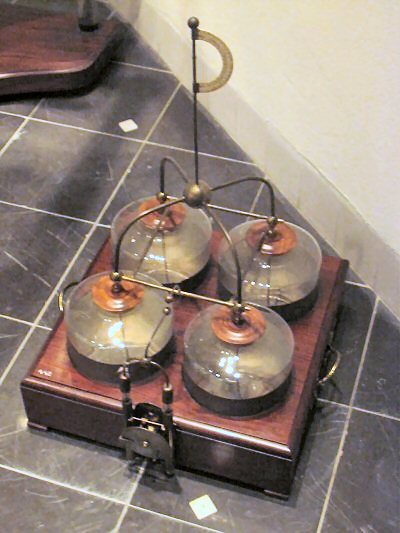|
Magnetic Drum
Drum memory was a magnetic data storage device invented by Gustav Tauschek in 1932 in Austria. Drums were widely used in the 1950s and into the 1960s as computer memory. Many early computers, called drum computers or drum machines, used drum memory as the main working memory of the computer. Some drums were also used as secondary storage as for example various IBM drum storage drives and the UNIVAC FASTRAND series of drums. Drums were displaced as primary computer memory by magnetic core memory, which offered a better balance of size, speed, cost, reliability and potential for further improvements. Drums were then replaced by hard disk drives for secondary storage, which were both less expensive and offered denser storage. The manufacturing of drums ceased in the 1970s. Technical design A drum memory or drum storage unit contained a large metal cylinder, coated on the outside surface with a ferromagnetic recording material. It could be considered the precursor to the ... [...More Info...] [...Related Items...] OR: [Wikipedia] [Google] [Baidu] |
Disk Read-and-write Head
A disk read-and-write head is the small part of a disk drive that moves above the disk platter and transforms the platter's magnetic field into electric current (reads the disk) or, vice versa, transforms electric current into magnetic field (writes the disk). The heads have gone through a number of changes over the years. In a hard drive, the heads ''fly'' above the disk surface with clearance of as little as 3 nanometres. The flying height has been decreasing with each new generation of technology to enable higher areal density. The flying height of the head is controlled by the design of an air bearing etched onto the disk-facing surface of the ''slider''. The role of the air bearing is to maintain the flying height constant as the head moves over the surface of the disk. The air bearings are carefully designed to maintain the same height across the entire platter, despite differing speeds depending on the head distance from the center of the platter. If the head hit ... [...More Info...] [...Related Items...] OR: [Wikipedia] [Google] [Baidu] |
University Of Manchester
The University of Manchester is a public university, public research university in Manchester, England. The main campus is south of Manchester city centre, Manchester City Centre on Wilmslow Road, Oxford Road. The University of Manchester is considered a red brick university, a product of the civic university movement of the late 19th century. The current University of Manchester was formed in 2004 following the merger of the University of Manchester Institute of Science and Technology (UMIST) and the Victoria University of Manchester. This followed a century of the two institutions working closely with one another. Additionally, the university owns and operates major cultural assets such as the Manchester Museum, The Whitworth art gallery, the John Rylands Library, the Tabley House, Tabley House Collection and the Jodrell Bank Observatory – a UNESCO World Heritage Site. The University of Manchester Institute of Science and Technology had its origins in the Manchester Mechan ... [...More Info...] [...Related Items...] OR: [Wikipedia] [Google] [Baidu] |
Harvard University
Harvard University is a Private university, private Ivy League research university in Cambridge, Massachusetts, United States. Founded in 1636 and named for its first benefactor, the History of the Puritans in North America, Puritan clergyman John Harvard (clergyman), John Harvard, it is the oldest institution of higher learning in the United States. Its influence, wealth, and rankings have made it one of the most prestigious universities in the world. Harvard was founded and authorized by the Massachusetts General Court, the governing legislature of Colonial history of the United States, colonial-era Massachusetts Bay Colony. While never formally affiliated with any Religious denomination, denomination, Harvard trained Congregationalism in the United States, Congregational clergy until its curriculum and student body were gradually secularized in the 18th century. By the 19th century, Harvard emerged as the most prominent academic and cultural institution among the Boston B ... [...More Info...] [...Related Items...] OR: [Wikipedia] [Google] [Baidu] |
University Of London
The University of London (UoL; abbreviated as Lond or more rarely Londin in Post-nominal letters, post-nominals) is a collegiate university, federal Public university, public research university located in London, England, United Kingdom. The university was established by royal charter in 1836 as a degree-awarding examination board for students holding certificates from University College London, King's College London and "other such institutions, corporate or unincorporated, as shall be established for the purpose of Education, whether within the Metropolis or elsewhere within our United Kingdom". It is one of three institutions to have claimed the title of the Third-oldest university in England debate, third-oldest university in England. It moved to a federal structure with constituent colleges in 1900. It is now incorporated by its fourth (1863) royal charter and governed by the University of London Act 2018 (c. iii). The university consists of Member institutions of the Un ... [...More Info...] [...Related Items...] OR: [Wikipedia] [Google] [Baidu] |
Birkbeck, University Of London
Birkbeck, University of London (formally Birkbeck College, University of London), is a Public university, public research university located in London, England, and a constituent college, member institution of the University of London. Established in 1823 as the London Mechanics' Institute by its founder Joseph Clinton Robertson and its supporters George Birkbeck, Jeremy Bentham, John Hobhouse, 1st Baron Broughton, J. C. Hobhouse and Henry Brougham, 1st Baron Brougham and Vaux, Henry Brougham, Birkbeck is one of the few universities to specialise in evening higher education in the United Kingdom. Birkbeck's main building is in Bloomsbury, in the London Borough of Camden in Central London. Birkbeck offers more than 200 undergraduate and postgraduate programmes. Birkbeck's academic activities are organised into five constituent faculties, which are subdivided into nineteen departments. The university is a member of academic organisations such as the Association of Commonwealth U ... [...More Info...] [...Related Items...] OR: [Wikipedia] [Google] [Baidu] |
Engineering Research Associates
Engineering Research Associates, commonly known as ERA, was a pioneering computer firm from the 1950s. ERA became famous for their numerical computers, but as the market expanded they became better known for their drum memory systems. They were eventually purchased by Remington Rand and merged into their UNIVAC department. Many of the company founders later left to form Control Data Corporation. Wartime origins of ERA The ERA team started as a group of scientists and engineers working for the US Navy during WWII on code-breaking, a division known as the Communications Supplementary Activity - Washington (CSAW). After the war budgets were cut for most military projects, including CSAW. Joseph Wenger of the Navy's cryptoanalytic group was particularly worried that the CSAW team would spread to various companies and the Navy would lose their ability to quickly design new machines. Post-war organization Wenger and two members of the CSAW team, William Norris and Howard Engst ... [...More Info...] [...Related Items...] OR: [Wikipedia] [Google] [Baidu] |
Capacitor
In electrical engineering, a capacitor is a device that stores electrical energy by accumulating electric charges on two closely spaced surfaces that are insulated from each other. The capacitor was originally known as the condenser, a term still encountered in a few compound names, such as the '' condenser microphone''. It is a passive electronic component with two terminals. The utility of a capacitor depends on its capacitance. While some capacitance exists between any two electrical conductors in proximity in a circuit, a capacitor is a component designed specifically to add capacitance to some part of the circuit. The physical form and construction of practical capacitors vary widely and many types of capacitor are in common use. Most capacitors contain at least two electrical conductors, often in the form of metallic plates or surfaces separated by a dielectric medium. A conductor may be a foil, thin film, sintered bead of metal, or an electrolyte. The nonconductin ... [...More Info...] [...Related Items...] OR: [Wikipedia] [Google] [Baidu] |
Magnetism
Magnetism is the class of physical attributes that occur through a magnetic field, which allows objects to attract or repel each other. Because both electric currents and magnetic moments of elementary particles give rise to a magnetic field, magnetism is one of two aspects of electromagnetism. The most familiar effects occur in ferromagnetic materials, which are strongly attracted by magnetic fields and can be magnetized to become permanent magnets, producing magnetic fields themselves. Demagnetizing a magnet is also possible. Only a few substances are ferromagnetic; the most common ones are iron, cobalt, nickel, and their alloys. All substances exhibit some type of magnetism. Magnetic materials are classified according to their bulk susceptibility. Ferromagnetism is responsible for most of the effects of magnetism encountered in everyday life, but there are actually several types of magnetism. Paramagnetic substances, such as aluminium and oxygen, are weakly attracted ... [...More Info...] [...Related Items...] OR: [Wikipedia] [Google] [Baidu] |
Capacitance
Capacitance is the ability of an object to store electric charge. It is measured by the change in charge in response to a difference in electric potential, expressed as the ratio of those quantities. Commonly recognized are two closely related notions of capacitance: ''self capacitance'' and ''mutual capacitance''. An object that can be electrically charged exhibits self capacitance, for which the electric potential is measured between the object and ground. Mutual capacitance is measured between two components, and is particularly important in the operation of the capacitor, an elementary linear electronic component designed to add capacitance to an electric circuit. The capacitance between two conductors depends only on the geometry; the opposing surface area of the conductors and the distance between them; and the permittivity of any dielectric material between them. For many dielectric materials, the permittivity, and thus the capacitance, is independent of the potential ... [...More Info...] [...Related Items...] OR: [Wikipedia] [Google] [Baidu] |
Kilobyte
The kilobyte is a multiple of the unit byte for Computer data storage, digital information. The International System of Units (SI) defines the prefix ''kilo-, kilo'' as a multiplication factor of 1000 (103); therefore, one kilobyte is 1000 bytes.International Standard IEC 80000-13 Quantities and Units – Part 13: Information science and technology, International Electrotechnical Commission (2008). The internationally recommended unit symbol for the kilobyte is kB. In some areas of information technology, particularly in reference to random-access memory capacity, ''kilobyte'' instead often refers to 1024 (210) bytes. This arises from the prevalence of sizes that are powers of two in modern digital memory architectures, coupled with the coincidence that 210 differs from 103 by less than 2.5%. The kibibyte is defined as 1024 bytes, avoiding the ambiguity issues of the ''kilobyte''.International Standard IEC 80000-13 Quantities and Units – Part 13: Information scien ... [...More Info...] [...Related Items...] OR: [Wikipedia] [Google] [Baidu] |








